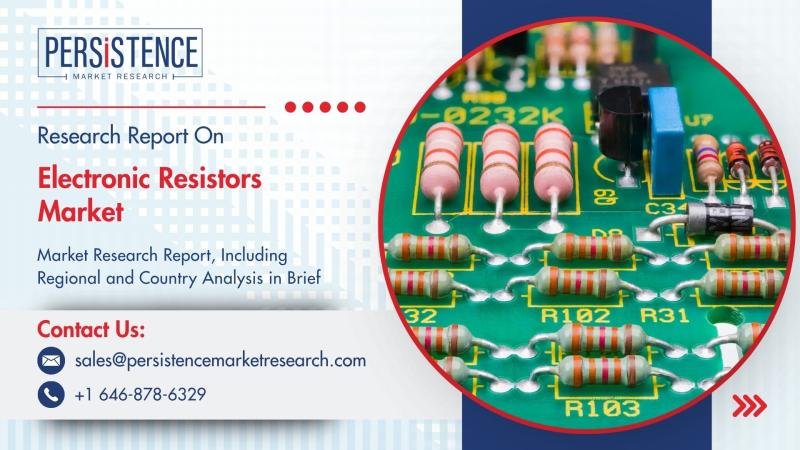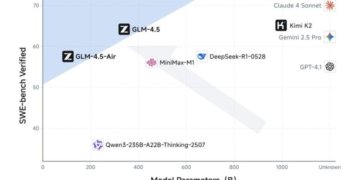According to the latest study by Persistence Market Research, the electronic resistors market is expected to grow at a compound annual growth rate (CAGR) of 3.7% from 2025 to 2032. The market is witnessing consistent demand across consumer electronics, industrial automation, and automotive sectors. Resistors are essential components in electronic circuits, offering precise control of voltage and current, which makes them indispensable in nearly every electronic device.
As technology evolves and products become more compact and power-efficient, the demand for high-precision and miniaturized resistors has increased. The automotive sector, in particular, is seeing a surge in the use of electronic resistors due to the rapid adoption of electric vehicles (EVs), where resistors play a crucial role in battery management systems and power distribution units. Thick film resistors have emerged as the leading product segment due to their cost-effectiveness, thermal stability, and widespread application across various electronic devices.
Get a Sample PDF Brochure of the Report (Use Corporate Email ID for a Quick Response): https://www.persistencemarketresearch.com/samples/21319
Geographically, Asia Pacific dominates the electronic resistors market. Countries like China, Japan, South Korea, and Taiwan lead in electronics manufacturing, supported by robust supply chains and high R&D investments. The region’s strong position is also fueled by the growing domestic demand for smart gadgets, EVs, and industrial electronics. The presence of major semiconductor manufacturers and component suppliers further solidifies Asia Pacific’s leadership in the global market.
✅Key Market Insights
➤ Thick film resistors account for the largest market share due to their low cost and high reliability in electronic circuits.
➤ Asia Pacific holds a dominant market share, driven by the region’s large-scale electronics production.
➤ Miniaturization and performance enhancement in consumer electronics are boosting demand for chip resistors.
➤ The increasing penetration of electric vehicles is a strong driver for precision resistors used in battery systems.
➤ Investments in Industry 4.0 and smart grid infrastructure are opening new opportunities in industrial resistor applications.
✅What are electronic resistors used for in modern electronics?
Electronic resistors are vital components in modern electronics used to control and regulate the flow of electric current within a circuit. They help in voltage division, current limiting, signal conditioning, and heat dissipation. In consumer devices like smartphones, TVs, and laptops, resistors manage power distribution and signal integrity. In automotive systems, they are key to battery regulation, lighting, and safety features. With the rise of connected devices and advanced industrial machinery, the use of resistors has become more critical than ever, enabling precise electrical performance and protecting sensitive electronic components from overload or failure.
✅Market Dynamics
Market Drivers:
The rise of smart electronics and IoT-enabled devices is a primary driver for the electronic resistors market. These components are essential in wearable technology, smart home products, and connected industrial equipment. Additionally, the growing adoption of EVs is increasing demand for high-power resistors for braking systems, powertrains, and battery packs. The expansion of telecommunications and 5G infrastructure also supports resistor integration in base stations and routers.
Market Restraining Factor:
Fluctuations in raw material prices, particularly for metals like copper and nickel used in resistor production, can impact profitability and market stability. Moreover, the highly competitive landscape and price wars among manufacturers may pressure margins, especially for low-cost resistor categories.
Key Market Opportunity:
Emerging applications in renewable energy systems and aerospace electronics offer untapped potential for precision resistors. High-reliability resistors used in satellites, military equipment, and solar inverters are expected to create lucrative growth opportunities in the coming years.
✅Market Segmentation
The electronic resistors market is segmented based on type and end-use industry, offering a comprehensive understanding of demand patterns. By type, the market includes thick film resistors, thin film resistors, wirewound resistors, metal oxide resistors, and others. Thick film resistors hold the largest share due to their robust performance and affordability. These resistors are commonly used in power supplies, lighting systems, and basic electronic circuits. Thin film resistors, on the other hand, offer higher precision and are preferred in applications requiring tighter tolerance and low noise, such as medical electronics and instrumentation.
By end-use industry, the market is categorized into automotive, consumer electronics, industrial, telecommunications, and others. The consumer electronics segment is the largest, driven by the proliferation of smartphones, gaming consoles, wearables, and smart TVs. The automotive segment is witnessing rapid growth due to the rising integration of electronic control units (ECUs) and infotainment systems. The industrial sector is another key area, where resistors are used in control systems, automation solutions, and robotics. The evolution of 5G and edge computing is also pushing demand in the telecom segment, which requires compact, thermally stable, and durable resistors.
✅Regional Insights
The Asia Pacific region leads the global electronic resistors market with a significant share, primarily due to the presence of major electronics hubs in China, South Korea, Japan, and Taiwan. The region’s dominance is driven by mass-scale manufacturing capabilities, cost efficiencies, and strong government support for technology sectors. The increasing adoption of electric vehicles and smart factories in the region adds further momentum to the resistor market.
North America follows as a prominent region due to advancements in automotive electronics, aerospace systems, and healthcare devices. The U.S. is at the forefront with high investments in defense and renewable energy, which also utilize high-performance resistors. Europe holds a steady market share with demand concentrated in Germany, the U.K., and France-mainly for automotive and industrial electronics. Emerging regions such as Latin America and the Middle East & Africa are slowly growing due to gradual technology adoption and urban infrastructure development.
✅Competitive Landscape
The electronic resistors market features a mix of global giants and regional manufacturers. Companies are focusing on strategic collaborations, product innovation, and capacity expansion to gain a competitive edge.
✅Company Insights
✦ Yageo Corporation
✦ Vishay Intertechnology, Inc.
✦ Panasonic Corporation
✦ ROHM Co., Ltd.
✦ TE Connectivity
✦ KOA Corporation
✦ Bourns, Inc.
✦ Murata Manufacturing Co., Ltd.
✦ TT Electronics Plc
✦ Ohmite Manufacturing Company
For Customized Insights on Segments, Regions, or Competitors, Request Personalized Purchase Options @ https://www.persistencemarketresearch.com/request-customization/21319
✅Key Industry Developments
In recent years, major players like Yageo and Vishay have focused on expanding their production capacities and enhancing their product portfolios. Yageo announced the expansion of its chip resistor manufacturing capabilities to meet growing global demand from automotive and telecom sectors. Meanwhile, Vishay introduced a new series of high-precision thin-film resistors designed for use in medical imaging and industrial automation.
Additionally, partnerships and acquisitions are shaping the market landscape. Bourns Inc. acquired assets from a leading precision resistor manufacturer to strengthen its presence in high-reliability applications. Murata Manufacturing has been actively investing in R&D to develop resistors capable of functioning in high-frequency and miniaturized electronics, especially in 5G-enabled devices.
✅Innovation and Future Trends
Innovation in the electronic resistors market is being driven by the demand for miniaturization, high-frequency compatibility, and thermal performance. With the development of ultra-thin film technologies, resistors are being integrated into compact circuits without sacrificing accuracy. These innovations are critical in the design of wearables, implantable medical devices, and next-gen consumer electronics. Manufacturers are also exploring the use of novel materials such as graphene and ceramics to enhance conductivity and heat resistance.
Looking ahead, AI-enabled resistor monitoring and self-healing circuits are expected to revolutionize smart electronics. As the Internet of Things (IoT) grows, the need for resistors that can adapt and adjust to real-time conditions is becoming more prominent. Energy-efficient and environmentally sustainable resistor production is also a growing trend, especially as regulations tighten around electronics waste. These advancements are likely to redefine the role of resistors in tomorrow’s digital and connected world.
✅Explore the Latest Trending “Exclusive Article” @
• https://medium.com/@apnewsmedia/automotive-human-machine-interface-hmi-market-key-drivers-and-challenges-5e1c9a61aebb
• https://theautonewz.wordpress.com/2025/06/16/automotive-human-machine-interface-hmi-market-size-forecast-to-2032/
• https://webrankmedia.blogspot.com/2025/06/automotive-human-machine-interface-hmi.html
• https://www.manchesterprofessionals.co.uk/article/marketing-pr/94421/automotive-human-machine-interface-hmi-market-demand-rising-with-ev-adoption
• https://vocal.media/stories/automotive-human-machine-interface-hmi-market-leading-technologies-in-2025
✅Contact Us:
Persistence Market Research
G04 Golden Mile House, Clayponds Lane
Brentford, London, TW8 0GU UK
USA Phone: +1 646-878-6329
UK Phone: +44 203-837-5656
Email: sales@persistencemarketresearch.com
Web: https://www.persistencemarketresearch.com
✅About Persistence Market Research:
At Persistence Market Research, we specialize in creating research studies that serve as strategic tools for driving business growth. Established as a proprietary firm in 2012, we have evolved into a registered company in England and Wales in 2023 under the name Persistence Research & Consultancy Services Ltd. With a solid foundation, we have completed over 3600 custom and syndicate market research projects, and delivered more than 2700 projects for other leading market research companies’ clients.
Our approach combines traditional market research methods with modern tools to offer comprehensive research solutions. With a decade of experience, we pride ourselves on deriving actionable insights from data to help businesses stay ahead of the competition. Our client base spans multinational corporations, leading consulting firms, investment funds, and government departments. A significant portion of our sales comes from repeat clients, a testament to the value and trust we’ve built over the years.
This release was published on openPR.












